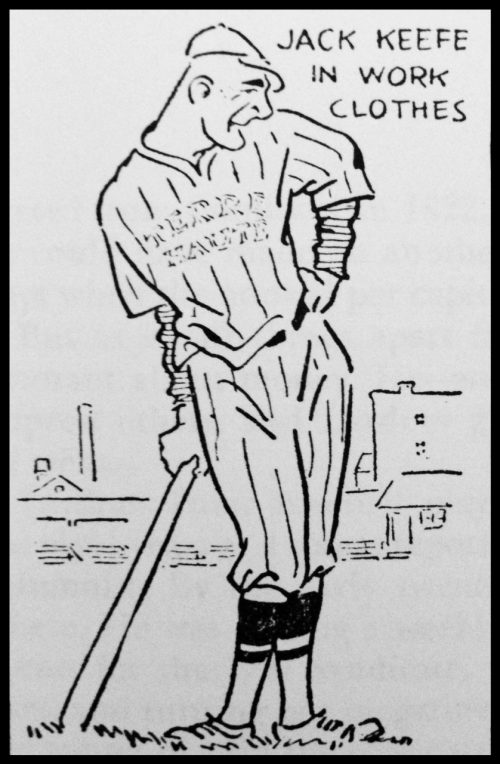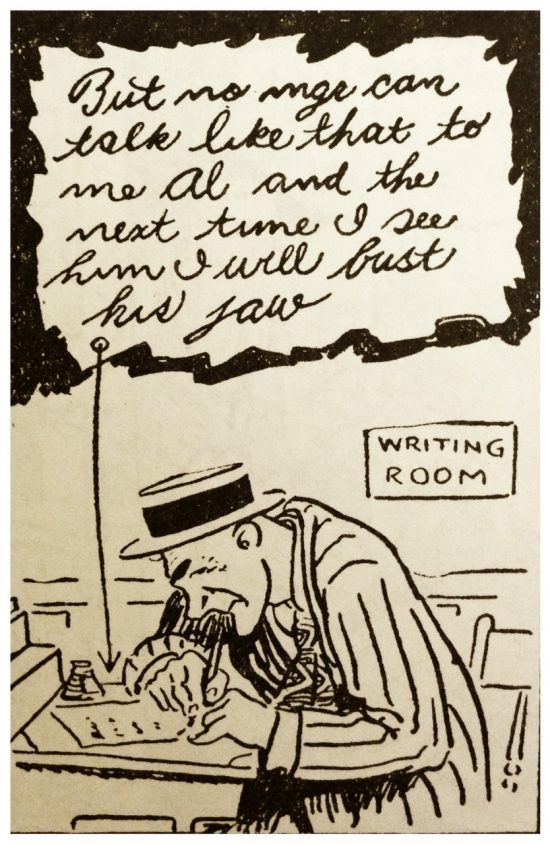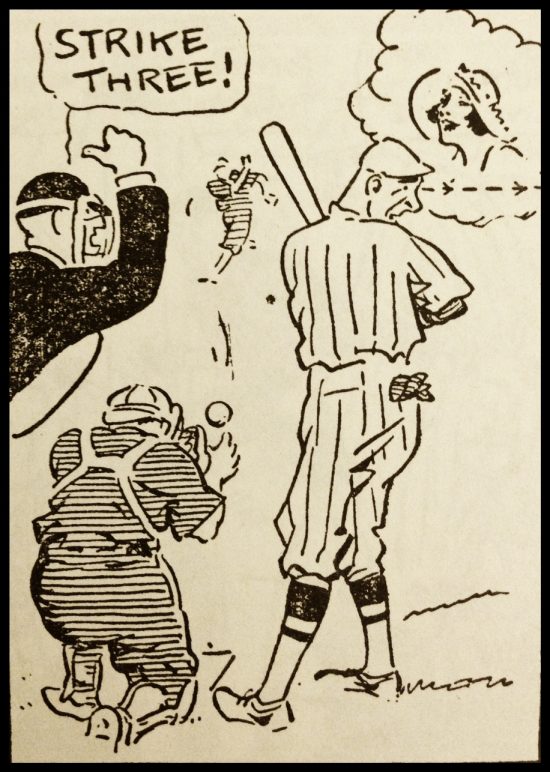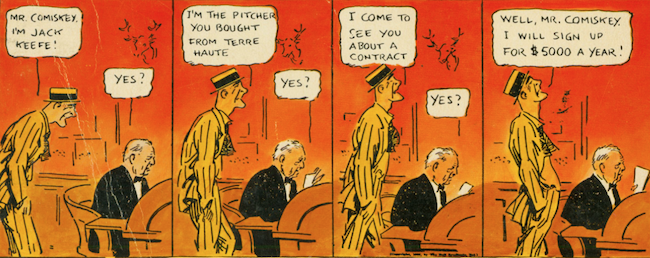The You Know Me Al letters have an unusual history, in terms of reputation. The impact of their original publication, forty-five years ago, was such that their fame has endured to a large extent by word of mouth, like that of New York’s blizzard of 1888. Mere memories of the prodigy have been handed down from one generation to another. It’s not necessary—as years of involuntary research have shown me—for someone to have read You Know Me Al to want to talk about it. I think that reading is better, because the letters are equal to their reputation and are equally timeless. But the fact of their continuing strength-through-hearsay remains, as a kind of literary curiosity. So does the fact that among people who have read them, they have been relished and judged from radically different points of view. I’ve known readers who associated them—delightedly—with the “funny-spelling” works of the Bill Nye school, which came earlier, and of Ed Streeter (“Dere Mable”), who came a little later. I’ve known readers who valued the language of the letters more highly than that, but who enjoyed them primarily as the most comical and engrossing baseball writing of all time. I’ve seen critical estimates that rated You Know Me Al as an all-around classic, or as a compact treasure-house of popular American English exactly observed and transcribed. On the whole, these cults have lived in perfect congeniality. As far as I know, no reader’s viewpoint has ever interfered with the pleasure of another reader.
It’s true that only a few of the readers or the knowing nonreaders of You Know Me Al have thought of it as a work of art. There’s a certain rough justice in that situation. The busher letters were not written with artistic prestige in mind. They were written because there was an urgent need around the home of the two hundred dollars that each of the first installments brought from The Saturday Evening Post. (Later, according to Donald Elder’s biography, Ring Lardner, which has more reliable information about those times than I have, Jack Keefe letters fetched up to twelve hundred and fifty dollars per installment. The cheaper installments—the ones that were incorporated in the book You Know Me Al—were the best.) Almost as soon as the Post began to publish them, the letters made their author as famous as the President of the United States. (They were to keep him famous in the same degree throughout the next two or three administrations.) This turn of events startled my father, but it totally failed to cause him to think of what he had written as literature.
At that stage, thanks to the atmosphere in which he worked and to his own ingrained shyness, he couldn’t think of anything he wrote in that way—although it may come to the same thing as conscious artistry that he struggled constantly to make his stuff as good and as true as it could be. A few years afterward, when H.L. Mencken, Gilbert Seldes, Franklin P. Adams, and others began to praise his work as art, he was deeply pleased—although, again, startled. He was critic enough himself, and his standards were severe enough, so that he sometimes pointed out, privately, what he thought were inaccuracies or inanities in some of the things that were written in his praise. In other words, he could react like a literary man when he was stimulated to do so. He had known when he wrote it that the language of You Know Me Al was right. He was bound to know—he had the world’s best ear. But it was impossible for him then, and hard at any time, to connect this sort of rightness, or rightness of character-drawing, in his own case, with the idea of artistic creation.

Some strong tributes have been paid to the literary importance of You Know Me Al. Probably the most striking is one that was written in England, in 1925, by Virginia Woolf, who didn’t know an infielder from a fungo bat and who approached all contemporary American writing in the spirit of an explorer of unknown territory. Earlier in the essay in question, she had said that Sinclair Lewis’s work had confused her by what she considered its self-consciousness—that Lewis seemed to be exhibiting and explaining American types in the style of an educated tourist guide, with his mind on British or European audiences.
“But Mr. Lardner,” she wrote, “is not merely unaware that we differ; he is unaware that we (the British) exist. When a crack player is in the middle of an exciting game of baseball he does not stop to wonder whether the audience likes the color of his hair. (Mr. Elder has noted that Mrs. Woolf may have guessed wrong in this detail.) All his mind is on the game. So Mr. Lardner does not waste a moment when he writes in thinking whether he is using American slang or Shakespeare’s English—whether he is proud of being American or ashamed of not being Japanese; all his mind is on the story. Hence, incidentally, he writes the best prose that has come our way. Hence we feel at last freely admitted to the society of our fellows.
“That this should be true of You Know Me Al, a story about baseball, a game which is not played in England, a story written often in a language which is not English, gives us pause. To what does he owe his success? Besides his unconsciousness … Mr. Lardner has talents of a remarkable order. With extraordinary ease and aptitude, with the quickest strokes, the surest touch, the sharpest insight, he lets Jack Keefe the baseball player cut out his own outline, fill in his own depths, until the figure of the foolish, boastful, innocent athlete lives before us. As he babbles out his mind on paper there rise up friends, sweethearts, the scenery, town, and country—all surround him and make him up in his completeness.”
Mrs. Woolf then raised a point that first struck me when it was made in reverse to indicate a weakness, rather than a strength—by F. Scott Fitzgerald in “Ring,” an obituary essay that appeared in The New Republic. “Ring” was a fine piece, eloquent, loving, and brilliantly written. I suspect, however, that some of its author’s reasoning was based on delayed intuitions summoned up for the occasion and shaped by his proselytizing instinct. I’ll quote briefly from a passage in which I think the spirit of do-it-my-way interfered with Fitzgerald’s sense of proportion.
He had been saying that Ring Lardner’s “achievement” fell short of what he was capable of, and speculating about my father’s unwillingness or inability to tackle presumably larger subjects than the ones he had handled in You Know Me Al and The Big Town and in his short stories.

“During those (sports-writing) years,” Fitzgerald wrote, “when most men of promise achieve an adult education, if only in the school of war, Ring moved in the company of a few dozen illiterates playing a boy’s game. A boy’s game, with no more possibilities in it than a boy could master, a game bounded by walls which kept out novelty or danger, change or adventure. This material, the observation of it under such circumstances, was the text of Ring’s schooling during the most formative period of the mind. A writer can spin on about his adventures after thirty, after forty, after fifty, but the criteria by which these adventures are weighed and valued are irrevocably settled at the age of twenty-five. However deeply Ring might cut into it, his cake had exactly the diameter of Frank Chance’s diamond.
One man’s period of creativity may be shorter—especially if his work has been cleaner and more painstaking—than another’s.
“Here was his artistic problem, and it promised future trouble. So long as he wrote within that enclosure the result was magnificent: within it he heard and recorded the voice of a continent. But when, inevitably, he outgrew his interest in it, what was Ring left with?”
This appraisal overlooks the fact that very little of what my father wrote during the last fourteen years—almost one-third—of his life had to do with baseball. It fails to consider that one man’s period of creativity may be shorter—especially if his work has been cleaner and more painstaking—than another’s. Also, it seems to me, it tends to belittle what had been done, the depth of the cut in the cake. I don’t know, frankly, just how genius works in the matter of dimensions—whether it can probe a wide body as deeply as it can a narrow one. I have an idea that it was the compactness of the material, and the intensity, the concentration, that it produced, that made my father’s stories as good as they were. This would apply to The Big Town, and to Broadway stories like “Some Like Them Cold” and “A Day with Conrad Green,” and to the old people’s story, ”The Golden Honeymoon” (which has a lot in common with You Know Me Al), as well as to baseball stories. It’s my feeling, an entirely respectful one, that Scott Fitzgerald was at his best when he wrote in tight focus, about neat, intricate, carefully coded systems of life in which he knew all the moves.
Mrs. Woolf has said: “It is no coincidence that the best of Mr. Lardner’s stories are about games, for one may guess that Mr. Lardner’s interest in games has solved one of the most difficult problems of the American writer; it has given him a clue, a centre, a meeting place for the diverse activities of people whom a vast continent isolates, whom no tradition controls. Games give him what society gives his English brother.”
I’m not sure that the problems that Mrs. Woolf spoke of were purely American even at the time she wrote. There was a good deal of writing in Europe in those days that was loose and garrulous, that teemed with unframed types and symbols. In the last ten or fifteen years—perhaps because the Second World War accelerated the decline of many traditions—there have been quantities of that kind of writing in nearly every country that publishes books. At any rate, I think it was lucky both for my father and for his readers that the things that interested him were snugly organized. His subjects suited his special abilities. He carried a sharp knife; with one stroke of it, in You Know Me Al, he laid bare all the vital parts of a man who, because he was a human being, was more meaningful than any type could be.

In other words, the author of You Know Me Al was able to do more than reproduce “the voice of a continent.” Still, what he accomplished in that direction was astonishing. As Mencken said in The American Language (1919), everything that had been observed about American English by the shrewdest scholars, and much that had not, was compressed into a single piece of fiction by a newspaper man—a writer who, obviously, had not read the findings of these scholars and who worked by ear and self-respect alone. As I’ve said, my father was exhilarated by Mencken’s learned notice. Also, whenever Mencken dissented, in phrases like “my own observation is” or “my own belief is,” my father swiftly—though privately—overrode the objections and alternatives, again by ear and from a sense of fitness. (He dissented strongly, for instance, from Mencken’s dissents in the matter of the participles “throwed” and “gave.” He thought that Mencken and other critics sometimes failed to allow for the differences between spoken American and written American.) I doubt if my father would ever have ruled publicly on questions like these if Mencken had not encouraged him to it by recognizing his gift. Still, when he did permit himself to criticize another writer’s “American” in print, which was rarely, he showed a scientific, and almost a proprietary, interest in the matter, along with an uneasy need to depreciate himself in the role of scholar. A review he wrote of John V.A. Weaver’s book of verse, In American, was both precise and apologetic.
But all the essential truth about ball-playing can be found in You Know Me Al. Its broader values to one side, there has never been a sounder baseball book.
The language in the book, he said, was “pure American, nearly. The few impurities are a lifesaver for the critic. We can’t hope to land a K.O. on the writer’s jaw, but we can fret him a little with a few pokes to the ear. For the most part, this organ has served Mr. Weaver well. But I think that on occasion it consciously or unconsciously plays him false. It has told him, for example, that we say everythin’ and anythin’. We don’t. We say somethin’ and nothin’, but we say anything and everything. There appears to be somethin’ about the y near the middle of both these words that impels us to acknowledge the g on the end of them. Mr. Weaver’s ear has also give or gave (not gi’n) him a bum hunch on thing itself. It has told him to make it thin’! But it’s a real effort to drop the g off this little word and, as a rule, our language is not looking for trouble.”
It was a long and not very relevant step to this kind of analysis from the entertainer’s mood in which the busher letters were written. There’s a long distance, too, between the views of Mencken and Mrs. Woolf and the untrained, reflexive pleasure of the public’s reaction to You Know Me Al. Mrs. Woolf has shown why ignorance of baseball need not prevent a reader from appreciating the book as a classic. But there is a great deal in it that she was bound to miss. For the knowledgeable, the baseball details are pure delight; the thirsty fan drinks them down like cold water. Many names and conditions that were topical in 1914—Cobb, Mathewson, the “Federals,” McGraw, the gracefully ruthless Comiskey, Walsh, the spitball, Cicotte, Buck Weaver—are historical now; but history, for the baseball-lover, is full of romance. And the baseball technique and dramatics of You Know Me Al are as timeless as the literary values.
Gilbert Seldes, in discussing what he felt was the iconoclastic effect of Al, wrote that “baseball has never recovered” from what my father did to its heroes. I think it’s true that there was an element of shock in the author’s treatment of Keefe and one or two other non-historical characters. I believe that Mr. Elder stated the point a little more reasonably when he said that baseball fandom was “far more ingenuous” before the First World War than it is now, and that You Know Me Al reduced the “baseball hero” (my father, however, did not make Keefe a type, or even necessarily a fans’ hero) to human dimensions. Baseball did not have to recover from You Know Me Al, because its hard assets had not been disturbed. The book did make an important change in a state of mind which Mr. Seldes, writing in the early 1920s, could recall vividly. Since then, there have been other changes in player attitudes and in fan habits with which the Keefe letters had nothing to do. It’s noteworthy that Al has survived change as easily as it has created it. Everything that is inherently sound in our national diversion, and everything that is characteristically silly, are fixed for all time in this story.

Superficially, ball players are not quite the same kind of people today as they were in Keefe’s day. Present times have developed a distinct athlete class, to which most professional players belong—a group of men at least semi-educated in classrooms as well as lavishly trained since early youth in sports. In former times, professional baseball was the chancy lot of a handful of average workingmen. Only a thin margin of luck and physical aptitude separated the ball player from the clerk, the cab-driver, the farmer, and the coalminer. The difference between old-time and present-day players is reflected partly in the jargon of the modern game. Keefe used a certain amount of shop-talk; but the new athlete class has greatly refined and expanded baseball culture, and its wordiness has infected fans and baseball writers and sportscasters (who to some extent have re-infected the players). The vocabulary of the game has become swollen with expertise, with “changeups” and “breaking stuff” and “hitting the ball where it is pitched” and “getting good wood on it” and “shading him a little toward left” and “three speeds of curve” and the whole prolix cult of the “slider.” “Inside ball,” which was a glamorous mystery in the heyday of McGraw and Mack, is now public property, and there is, ostensibly, a hell of a lot more of it than there used to be.
But all the essential truth about ball-playing can be found in You Know Me Al. Its broader values to one side, there has never been a sounder baseball book. The story flows along with unpretentious smoothness. But if you stop to pick over the accounts of ball games, you see that each detail is correct in relation to place, weather, time of year, and the hitting, pitching, or fielding idiosyncrasies of each of a hundred players. Baseball strategy is set down as accurately as the speech and characters of Keefe, his friends, his girls, and his in-laws. I have never read a piece of baseball fiction, besides this one, in which there was no technical mistake. (Thirty-odd years ago, my father and mother worried and conferred when I was caught reading a novel about flaming youth called The Plastic Age. But my father was even more worried when he caught me reading a baseball novel called Won in the Ninth. He didn’t take it away from me, but he warned me not to let my mind be soiled by corrupt observation of baseball procedures.)
There is one more salient point about You Know Me Al. It is funny. The fact has gone unmentioned, or been taken for granted, by Mrs. Woolf, Mencken, Fitzgerald, and others as they studied the literary or scientific aspects of the book. But Al knocked the country head over heels in the first place because people laughed at it, so intensely that the echoes have been accepted at face value ever since. My feeling about nonreaders and tradition-carriers is that they also serve. But reading, as I said before, is better.
[Illustrations by Dick Dorgan]
